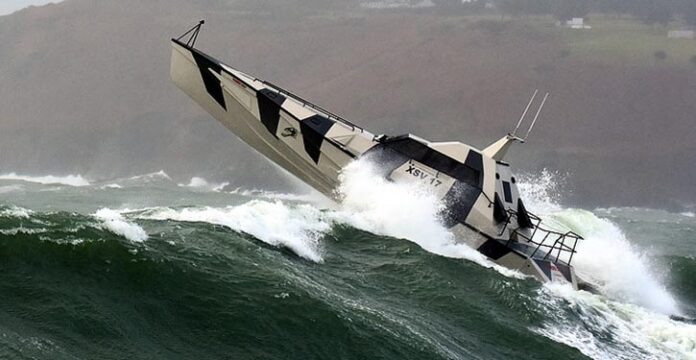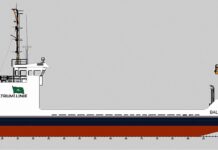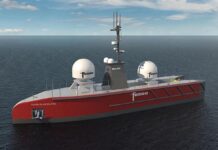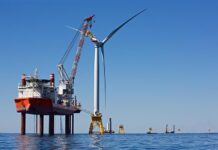Safehaven Marine, based in Cork / Ireland, are designers and builders of professional FRP Pilot vessels, Patrol boats, Crew transfer vessels, Hydrographic survey catamarans and Naval & Military craft, have now launched their latest new design: The XSV 17 THUNDER CHILD
According to the shipyard owner Frank Kowalski “… the XSV 17 is a development of the companies new Barracuda range of high speed, low RCS Interceptor / patrol craft for commercial, S.A.R. and naval operations. The new design brings even greater capabilities incorporating greater speed, greater range, higher crew capacity and an even lower RCS”.
The first of class THUNDER CHILD is an undeniably striking and stylish craft, however the resulting sleek profile is purely as a result of form following function due to her unique design features, which combine a high speed wave piercing hull design with a low radar signature superstructure. The principle dimensions of XSV 17 are an L.O.A. of 18m (17.3m moulded) a 4m beam and a draft of 0.85m.
XSV has an innovative and unique hull form that allows it to operate in two distinct modes, fully planing and wavepiercing. The hull combines a deep V hull form with a 24 degree transom deadrise for her aft planning area with a wave piercing bow, which is designed to run clear of the water at high speeds reducing drag and maximising speed, but which can be bought into dynamic effect with running trim control from large hydraulic trim tabs allowing the bow to become wavepiercing and dramatically reduce slamming in head seas thereby maximising endurance for her crew when operating in rough conditions. Another unique feature is adjustable anti-submersion fins at her bow, hydraulic in operation they can be adjusted for speed and wave height and prevent excessive submersion in large following seas in very rough conditions when speed inevitably must be reduced.
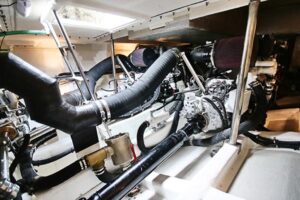
The hull provides exceptionally high levels of seakeeping abilities on all courses with its twin chine arrangements providing for high levels of both static and dynamic stability. The design allows for high maximum speeds of more than 60 kts with propulsion either by surface drives or hybrid waterjets, the latter allowing speeds of over 50 kts. The first of class vessel THUNDER CHILD featured here uses surface drive propulsion supplied by Metamarine of Italy and is powered by a pair of Caterpillar C12.9 providing each 745 kW engines and is achieving over 56 kts at present with more to come, and has an over 45 kts cruise speed. Long range fuel tanks provide a range of about 700 nm.
XSV 17 has a crew capacity that allows for up to 12 persons to be seated, all on shock mitigation seating in her climate controlled main cabin, which has been designed to offer maximum visibility and situational awareness in a comfortable, secure and highly focused environment for multi role operations, offering up to four individual command positions with their own consoles. The seats fitted on this new design are ‘Wavebreaker’ shock mitigation suspension units and carbon race bucket seats developed and supplied by AMP Power in Holland, which dramatically increase crew endurance in rough seas. The design of her large forward cabin allows a modular configuration and has been configured so that it can function in three operational roles with conversion undertaken quickly and easily between: Pursuit and interception, in which case a modular self contained weapon deployment system incorporating a 12.7mm gyroscopically stabilised, remote controlled machine gun which can be raised above decks through watertight hatches for deployment. In this way when the vessel is in engaged in surveillance or patrol, the main weapons are concealed and the vessels RCS signature is reduced. When the vessel is engaged in pursuit or apprehend modes, the weapons are raised for deployment. Another advantage being that the weapons are hidden when not in use for security, durability and covert reasons, as well as greatly reducing the vessels VCG, very beneficial, in heavy weather.
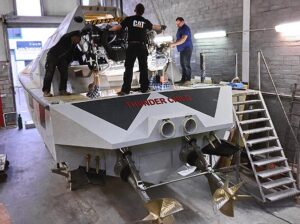
The second operational role is extended offshore patrol, in which case full live aboard accommodation is provided in a large, spacious forward cabin. The third role being S.A.R. operations or troop deployment. In this role an additional 16 survivors / combatants can be carried. For S.A.R. roles the design is fully ‘self-righting’ able to recover after capsize by a large breaking wave. Her performance enables much faster emergency response times than conventional S.A.R. craft designs, virtually doubling their speed capabilities, and with statistics indicating over 90% of incidents occurring in fair to moderate conditions where XSV’s higher speeds could be utilised, the ability to offer faster response times can crucially make a significant difference in saving lives. In extreme conditions the design still offers a high degree of survivability, albeit at reduced speeds.
The design of XSV 17 utilizes various stealth technology’s to produce a lower RCS (radar cross section), which can be optionally offered allowing it to operate with a very high degree of invisibility to an adversary’s radar. Stealth technologies are employed in the superstructure and hull design utilizing flat plane principles to its surfaces in its front, aft and cabin side projections to deflect radar beams away from source. These unique features work together with RAM and specialized outfitting, to produce a vessel with a very significantly lower than normal RCS primarily from forward and rear aspects but also to a high level in side aspects. Safehaven’s ‘stealth’ capabilities have been independently Naval Service tested and proven to offer a ‘very significantly’ lower RCS than conventional craft. Operational practicality and crew safety is maintained by utilisation of safe, boarding capable side decks and aft cockpit space.
XSV 17 is built from advanced lightweight cored composite construction for her hull and superstructure, offering a low dialectic, light weight and high strength. Her windows were specially developed by the Irish boat manufacturer specialists for maximum strength and lightness by utilising hard coated 12mm polycarbonate with an additional outer protective film for the side windows, embedded directly in the FRP structure, with 18mm laminated glass steeply raked to minimise pressure loadings from green seas utilised for the forward screens.
As well as a full array of navigation equipment including HD Radar, radio communications, AIS, CCTV and GPS systems, all supplied by Garmin on Thunder Child, a range of specialised sensors are offered enabling multi task operational control. FLIR Thermal /night vision infrared camera systems are fitted for surveillance and night time operations. Hyperspike and ROSY (Rapid obscuring system) can be integrated concealed below decks and remotely raised through watertight hatches for deployment.

